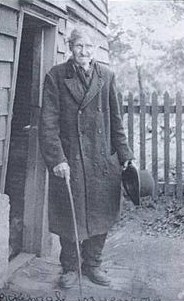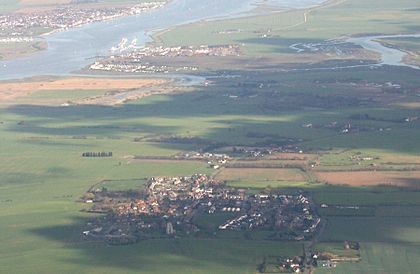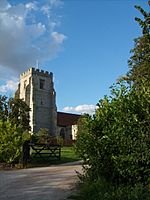George Pickingill facts for kids
Quick facts for kids
George Pickingill
|
|
|---|---|

Photograph allegedly of Pickingill taken in the late nineteenth or early twentieth century.
|
|
| Born | Circa 1816 Hockley, Essex
|
| Died | 10 April 1909 Canewdon, Essex
|
| Occupation | Cunning man, farm labourer |
| Spouse(s) | Sarah Ann Bateman (m. 1856–87) |
| Children | Martha Ann, Charles Frederick, Mary Ann, George |
| Parent(s) | Charles Pickingill, Susannah Cudner |
George Pickingill (around 1816 – 10 April 1909) was an English farm worker. He lived and worked in the village of Canewdon in Essex, a county in eastern England. Many people thought he was a cunning man, which is like a folk magician. People said he used magic to help cure sicknesses and find lost things. However, some also claimed he would threaten to put curses on people.
George was born into a working-class family in the countryside. He grew up in Hockley, Essex, and was baptised into the Church of England. He worked as a farm labourer. In 1856, he married Sarah Ann Bateman in Gravesend, Kent. The couple moved back to Essex, settled in Canewdon, and had four children. George's wife died in 1887. Later in his life, he got some attention from newspapers because he claimed to be one of the oldest men in England. These claims also appeared when he died, but they were later found to be wrong.
In the early 1960s, a folklorist named Eric Maple helped make Pickingill more widely known. Maple was studying beliefs about folk magic and witchcraft in Essex during the 1800s. He talked to many people in Canewdon and collected their stories about Pickingill and his reputation as a cunning man.
According to these stories, Pickingill had visitors from all over Essex who wanted his magical help. He didn't charge money for his services. People believed he could control animals and make imps (which are like small spirit helpers) do what he wanted. They also thought he had power over six or nine mean witches who lived in Canewdon. It was also said that he could get local people to help him or give him beer by threatening to put a curse on them or their things. Some people have suggested that the locals might have made up some stories to please Maple, possibly using older tales about another Essex cunning man named James Murrell. However, later research by historian Ronald Hutton has shown that some parts of Maple's original stories were true.
In the 1970s, an occultist named E.W. "Bill" Liddell started saying that secret witch families had told him Pickingill was more than just a village cunning man. Liddell claimed Pickingill was a very important person in the world of magic in the 1800s. According to Liddell, Pickingill was part of a special group of witches. He supposedly led a coven (a group of witches) in Canewdon and started nine other covens across southern England. Liddell said that Pickingill changed the way English witchcraft worked by adding new ideas from French and Danish witchcraft and from old Greek and Roman times. He claimed that Pickingill's changes led to the creation of Gardnerian Wicca in the 1950s. However, many well-known Wiccans like Doreen Valiente and Lois Bourne, and historians like Maple, Hutton, Owen Davies, and Aidan A. Kelly, have said that Liddell's claims are not true.
Contents
George Pickingill's Life
Early Years and Family
George Pickingill was the son of Charles Pickingill, who worked as a labourer and blacksmith, and Susannah Cudner. His parents got married in 1813. George was baptised on May 26, 1816, at the church in Hockley, though there is no known birth record for him. The exact year of his birth is a bit unclear because he gave different ages in different official records. For example, in the 1851 census, he said he was 26, but in the 1861 census, he said he was 46. By 1901, he claimed to be 95! Some people think he made himself sound older to get help from the church. George also used different spellings for his last name on official papers, like Pickengill and Pettingale.
Records show that George lived with his parents until the 1830s. In 1851, he was staying with David Clemens in Little Wakering, Essex, and worked as a farm labourer. On May 18, 1856, he married Sarah Ann Bateman at St George's Church in Gravesend, Kent. Both George and Sarah Ann said they lived in Gravesend at the time. Sarah Ann was born around 1831 in Tillingham, Essex. After they married, she often used the name "Mary Ann Pickingill."
Their daughter, Martha Ann, was born in Hawkwell, Essex, in 1858. By 1861, the family had moved to Eastwood, Essex, where George continued to work as an agricultural labourer. Their son, Charles Frederick, was born that same year. In 1863, another daughter, Mary Ann, was born.
Sometime in the next four years, the Pickingill family moved to Canewdon. Another son, George, was born there in 1876. The 1871 census showed George, his wife, and their four children living together, with George still working as a farm labourer. In 1881, George and his wife were living with two of their children, Mary Ann and George.
On September 13, 1887, George's wife died in Canewdon at age 63. She was buried at Canewdon's St. Nicholas Church. The 1891 census showed George still working as a farm labourer. He was living in Canewdon with his married daughter Mary Ann and his granddaughter, Emily Wood. By 1901, he was getting help from the church, and his two sons were living with him again.
Around this time, George started saying he was much older than he was, eventually claiming to be 105 years old. This got attention, even from London. In September 1908, a journalist visited Canewdon. The journalist arrived in a car, which George had never seen before, and let him ride in it. The journalist wrote an article about the supposedly very old man, calling him "Frederick Pickingale." It's possible George gave a false name so no one could check his real age in the church records.
Eric Maple described Pickingill as "a tall, unkempt man, solitary and uncommunicative." He also noted that George had very long fingernails and kept his money in a bag made of sacking.
Magical Abilities and Reputation
The first time George Pickingill was written about as a cunning man was 50 years after he died. This was thanks to the folklorist Eric Maple. Maple was studying old traditions about witchcraft and magic in Essex. He visited Canewdon in 1959-1960 and talked to many older residents. They shared various stories about magic in the village. Maple published his findings in 1960 in a journal called Folklore. He later wrote a popular book, The Dark World of Witches (1962), where he shared many of the stories about Pickingill.
Maple noted that Pickingill didn't usually charge for his services, which was unusual for a cunning man. However, he did receive some money from visitors. People said he could find lost items and cure small illnesses, which were common things cunning folk did in Britain. One story said he cured a woman's rheumatism (a type of joint pain) by moving it to her father. Maple also wrote that Pickingill sometimes used cursing or bad magic. For example, during harvest time, he would walk around fields threatening to bewitch farm machines. Many farmers would then offer him beer to get him to leave them alone. He was also said to make local people get water for him from the village pump by threatening to send white mice after them. White mice were thought to bring bad luck in local stories.
Pickingill was also known for being able to control animals, especially horses. People believed that if he hit a hedgerow (a line of bushes) with his stick, game animals would run out, ready to be caught and eaten. It was also rumored that he could do things much faster than normal people. Some believed he had his imps (his spirit helpers) do the work for him. Maple also mentioned that visitors to Pickingill's cottage sometimes said they saw furniture dancing around the room by itself. Maple thought this story might have come from a Dutch folk tale, as many Dutch people settled in Essex in the 1600s.
According to Maple, Pickingill was so well known in Essex that people came from "great distances" to visit him for magical help. Canewdon itself became known as "The Witch Country" by the late 1800s. Many wagon drivers avoided it because they feared their wagons would be bewitched. This might have been because Canewdon was quite isolated, surrounded by marshland, and its community was very close-knit. Maple heard a rumor that there were either six or nine old women living in Canewdon who were mean witches. People believed these witches didn't know each other, but they all answered to one wizard or "master of witches." The local rumor was that Pickingill was this master. It was said that as the "Master of Witches," Pickingill only had to whistle for these nine witches to stand at their doors and show who they were. Or, he could "will them" to dance for him in the local churchyard.
Other researchers also visited Canewdon to talk to Maple's sources. In 1967, Ronald Hutton met Lillian Garner, one of Maple's informants. He also found a new informant, Jack Taylor, who said he knew Pickingill as a young man. Taylor claimed Pickingill could "horse-whisper," meaning he had a magical ability to control horses. Hutton found that the stories about Pickingill from the local people matched what Maple had reported. In 1977, Michael Howard, a Wiccan, also met Lillian Garner. She told him that her own mother had said Pickingill led a local coven and had "many visitors" from "a long way away" who wanted his magical knowledge.
However, some people have since said that Pickingill was not a cunning man at all. Sylvia Webster, a local Canewdon historian, told Howard that the stories about Pickingill's magic might have been made up by locals to impress Maple. She pointed out that there was no proof of Pickingill being a cunning man before Maple's books. Similarly, Richard Ward argued that newspaper articles and interviews with Pickingill from his time didn't mention any magical activities. Ward suggested that many of the stories about Pickingill's magic were actually taken from tales about a real Essex cunning man named James Murrell. Hutton disagreed with Ward, pointing to his own research and interviews as proof that Pickingill "seems little doubt" was a cunning man. However, Hutton also agreed that some legends about Murrell might have been linked to Pickingill.
George Pickingill's Death
According to Eric Maple, in the last few weeks of George Pickingill's life, when he was very ill, local people moved him to the infirmary (a type of hospital) against his wishes. There, he supposedly declared that at his funeral, there would be one more display of his magical powers. Many locals believed this came true when the hearse (the vehicle carrying his coffin) arrived at the churchyard, and the horses suddenly stepped out of their harness shafts.
George Pickingill's body was buried in the church's graveyard. His old house slowly fell apart after he left it.
According to his death certificate, "George Pettingale" died on April 10, 1909, at the age of 103. The cause of death was listed as "old age" and "heart failure." He was buried at Canewdon's St Nicholas Church on April 14. Although his age was recorded as 103, the vicar added a note saying this was wrong. The vicar wrote that George was "born at Hockley 1816 [and] was only in his 93rd year."
George Pickingill's death was even reported in national newspapers. Both the Essex Newsman and The Times claimed he was "believed to be the oldest man in England," reporting his age as 106. A New Zealand newspaper, The Star, also picked up the story, calling him "the oldest man in England."
Maple said that Pickingill left behind "a legacy of myth which is curiously alien to the general run of witch traditions." He felt there was a strange feeling of horror in the stories about Pickingill, perhaps because many of the people telling the tales had actually known him and felt a quiet fear when he passed them in the village.
Later Claims About Pickingill
In the 1970s, a writer named E.W. "Bill" Liddell started publishing articles claiming that George Pickingill was a very important figure in the world of modern witchcraft. Liddell said that Pickingill was not just a simple cunning man but had a big role in shaping how witchcraft developed in England. He claimed that Pickingill was part of a secret, old tradition of witchcraft and that he helped create the structure for what later became Gardnerian Wicca.
Liddell's claims were often confusing and changed over time. He said he got his information from different secret sources, but historians like Ronald Hutton have pointed out that Liddell's stories sounded like they came from one person making things up. Liddell claimed that Pickingill had links to Romani people and that he hated Christianity. He also said Pickingill traveled to France and brought new ideas back to English witchcraft, including the idea that a coven should be led by a woman. Liddell even claimed that famous occultists like Aleister Crowley and Gerald Gardner (who founded Gardnerian Wicca) were connected to Pickingill's covens.
However, historians and scholars of religion have looked into Liddell's claims and found no real evidence to support them. They believe that Liddell's stories are not true and that George Pickingill was mainly known as a local cunning man, not a major leader in the occult world.



